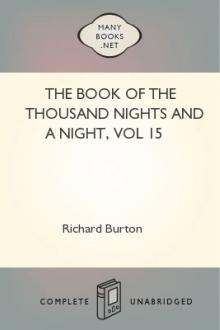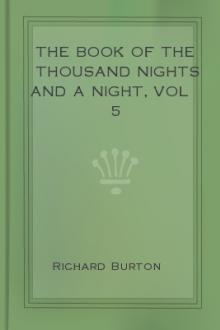The Book of the Thousand Nights and a Night, vol 6 by Sir Richard Francis Burton (best novels for students txt) 📖

- Author: Sir Richard Francis Burton
- Performer: -
Book online «The Book of the Thousand Nights and a Night, vol 6 by Sir Richard Francis Burton (best novels for students txt) 📖». Author Sir Richard Francis Burton
and Sa’adan said to them, “Pinion your King.”—And Shahrazad saw the dawn of day and ceased saying her permitted say, End of Vol 6.
Arabian Nights, Volume 6
Footnotes
[FN#1] Lane (vol. iii. 1) calls our old friend “Es-Sindib�d of the Sea,” and Benfey derives the name from the Sanskrit “Siddhapati”=lord of sages. The etymology (in Heb. Sandabar and in Greek Syntipas) is still uncertain, although the term often occurs in Arab stories; and some look upon it as a mere corruption of “Bidpai” (Bidy�pati). The derivation offered by Hole (Remarks on the Arabian Nights’ Entertainments, by Richard Hole, LL.D. London, Cadell, 1797) from the Persian �b�d (a region) is impossible. It is, however, not a little curious that this purely Persian word (=a “habitation”) should be found in Indian names as early as Alexanders’ day, e.g. the “Dachina bades” of the Periplus is “Dakhsin-�b�d,” the Sanskr. being “Dakshinapatha.”
[FN#2] A porter like the famous Armenians of Constantinople. Some edits. call him “Al-Hindib�d.”
[FN#3] Arab. “Karaw�n” (Charadrius �dicnemus, Linn.): its shrill note is admired by Egyptians and hated by sportsmen.
[FN#4] This ejaculation, still popular, averts the evil eye. In describing Sindbad the Seaman the Arab writer seems to repeat what one reads of Marco Polo returned to Venice.
[FN#5] Our old friend must not be confounded with the eponym of the “Sindib�d-n�mah;” the Persian book of Sindbad the Sage. See Night dlxxviii.
[FN#6] The first and second are from Eccles. chapts. vii. 1, and ix. 4. The Bul. Edit. reads for the third, “The grave is better than the palace.” None are from Solomon, but Easterns do not “verify quotations.”
[FN#7] Arab. “K�n�n”; a furnace, a brasier before noticed (vol.
v., p. 272); here a pot full of charcoal sunk in the ground, or a little hearth of clay shaped like a horseshoe and opening down wind.
[FN#8] These fish-islands are common in the Classics, e.g. the Pristis of Pliny (xvii. 4), which Olaus Magnus transfers to the Baltic (xxi. 6) and makes timid as the whales of Nearchus. C. J.
Solinus (Plinii Simia) says, “Indica maria bal�nas habent ultra spatia quatuor jugerum.” See also Bochart’s Hierozoicon (i. 50) for Job’s Leviathan (xli. 16-17). Hence deemed an island. A basking whale would readily suggest the Krakan and Cetus of Olaus Magnus (xxi. 25). Al-Kazw�ni’s famous treatise on the “Wonders of the World” (Aj�ib al-Makhl�k�t) tells the same tale of the “Sulahfah” tortoise, the colossochelys, for which see Night dl.
[FN#9] Sindbad does not say that he was a shipwrecked man, being a model in the matter of “travellers’ tales,” i.e. he always tells the truth when an untruth would not serve him.
[FN#10] Lane (iii. 83) would make this a corruption of the Hindu “Mahar�j”=great Rajah: but it is the name of the great autumnal f�te of the Guebres; a term composed of two good old Persian words “Mihr” (the sun, whence “Mithras”) and “j�n”=life. As will presently appear, in the days of the Just King Anushirw�n, the Persians possessed Southern Arabia and East Afica south of Cape Guardafui (Jird H�f�n). On the other hand, supposing the word to be a corruption of Maharaj, Sindbad may allude to the famous Narsinga kingdom in Mid-south India whose capital was Vijayanagar; or to any great Indian Rajah even he of Kachch (Cutch), famous in Moslem story as the Balhar� (Ballaba Rais, who founded the Ballabhi era; or the Zamorin of Camoens, the Samdry Rajah of Malabar). For Mahrage, or Mihrage, see Renaudot’s “Two Mohammedan Travellers of the Ninth Century.” In the account of Ceylon by Wolf (English Transl. p. 168) it adjoins the “Ilhas de Cavalos”
(of wild horses) to which the Dutch merchants sent their brood-mares. Sir W. Jones (Description of Asia, chapt. ii.) makes the Arabian island Soborma or Mahr�j=Borneo.
[FN#11] Arab. “S�is”; the well-known Anglo-Indian word for a groom or rather a “horse-keeper.”
[FN#12] Arab. “Darakah”; whence our word.
[FN#13] The myth of mares being impregnated by the wind was known to the Classics of Europe; and the “sea-stallion” may have arisen from the Arab practice of picketing mare asses to be covered by the wild ass. Colonel J. D. Watson of the Bombay Army suggests to me that Sindbad was wrecked at the mouth of the Ran of Kachch (Cutch) and was carried in a boat to one of the Islands there formed during the rains and where the wild ass (Equus Onager, Khar-gadh, in Pers. Gor-khar) still breeds. This would explain the “stallions of the sea” and we find traces of the ass blood in the true Kathiaw�r horse, with his dun colour, barred legs and dorsal stripe.
[FN#14] The second or warrior caste (Kshatriya), popularly supposed to have been annihilated by Battle-axe Ram� (Parashu R�ma); but several tribes of Rajputs and other races claim the honourable genealogy. Colonel Watson would explain the word by “Shakh�y�t” or noble K�this (Kathiawar-men), or by “Shik�ri,” the professional hunter here acting as stable-groom.
[FN#15] In Bul. Edit. “K�bil.” Lane (iii. 88) supposes it to be the “Bartail” of Al-Kazwini near Borneo and quotes the Spaniard B. L. de Argensola (History of the Moluccas), who places near Banda a desert island, Poelsatton, infamous for cries, whistlings, roarings and dreadful apparitions, suggesting that it was peopled by devils (Stevens, vol. i., p. 168).
[FN#16] Some texts substitute for this last phrase, “And the sailors say that Al-Dajj�l is there.” He is a manner of Moslem Antichrist, the Man of Sin per excellentiam, who will come in the latter days and lay waste the earth, leading 70,000 Jews, till encountered and slain by Jesus at the gate of Lud. (Sale’s Essay, sect. 4.)
[FN#17] Also from Al-Kazwini: it is an exaggerated description of the whale still common off the East African Coast. My crew was dreadfully frightened by one between Berberah and Aden. Nearchus scared away the whales in the Persian Gulf by trumpets (Strabo, lib. xv.). The owl-faced fish is unknown to me: it may perhaps be a seal or a manatee. Hole says that Father Martini, the Jesuit (seventeenth century), placed in the Canton Seas, an “animal with the head of a bird and the tail of a fish,”�a parrot-beak?
[FN#18] The captain or master (not owner) of a ship.
[FN#19] The kindly Moslem feeling, shown to a namesake, however humble.
[FN#20] A popular phrase to express utter desolation.
[FN#21] The literature of all peoples contains this physiological perversion. Birds do not sing hymns; the song of the male is simply to call the female and when the pairing-season ends all are dumb.
[FN#22] The older “roc.” The word is Persian, with many meanings, e.g. a cheek (Lalla “Rookh”); a “rook” (hero) at chess; a rhinoceros, etc. The fable world-wide of the wundervogel is, as usual, founded upon fact: man remembers and combines but does not create. The Egyptian Bennu (Ti-bennu=phoenix) may have been a reminiscence of gigantic pterodactyls and other winged monsters.
From the Nile the legend fabled by these Oriental “putters out or five for one” overspread the world and gave birth to the Eorosh of the Zend, whence the Pers. “S�murgh” (=the “thirty-fowl-like”), the “Bar Yuchre” of the Rabbis, the “Garuda” of the Hindus; the “Ank�” (“long-neck”) of the Arabs; the “Hathilinga bird,” of Buddhagosha’s Parables, which had the strength of five elephants; the “Kerkes” of the Turks; the “Gryps” of the Greeks; the Russian “Norka”; the sacred dragon of the Chinese; the Japanese “Pheng” and “Kirni”; the “wise and ancient Bird” which sits upon the ash-tree yggdrasil, and the dragons, griffins, basilisks, etc. of the Middle Ages. A second basis wanting only a superstructure of exaggeration (M. Polo’s Ruch had wing-feathers twelve paces long) would be the huge birds but lately killed out.
Sindbad may allude to the �pyornus of Madagascar, a gigantic ostrich whose egg contains 2.35 gallons. The late Herr Hildebrand discovered on the African coast, facing Madagascar, traces of another huge bird. Bochart (Hierozoicon ii. 854) notices the Avium Avis Ruch and taking the pulli was followed by lapidation on the part of the parent bird. A Persian illustration in Lane (iii. 90) shows the Rukh carrying off three elephants in beak and pounces with the proportions of a hawk and field mice: and the Rukh hawking at an elephant is a favourite Persian subject. It is possible that the “Twelve Knights of the Round Table” were the twelve Rukhs of Persian story. We need not go, with Faber, to the Cherubim which guarded the Paradise-gate. The curious reader will consult Dr. H. H. Wilson’s Essays, edited by my learned correspondent, Dr. Rost, Librarian of the India House (vol. i.
pp. 192-3).
[FN#23] It is not easy to explain this passage unless it be a garbled allustion to the steel-plate of the diamond-cutter. Nor can we account for the wide diffusion of this tale of perils unless to enhance the value of the gem. Diamonds occur in alluvial lands mostly open and comparatively level, as in India, the Brazil and the Cape. Archbishop Epiphanius of Salamis (ob.
A.D. 403) tells this story about the jacinth or ruby (Epiphanii Opera, a Petaio, Coloni� 1682); and it was transferred to the diamond by Marco Polo (iii. 29, “of Eagles bring up diamonds”) and Nicolo de Conti, whose “mountain Albenigaras” must be Vijayanagar in the kingdom of Golconda. Major Rennel places the famous mines of Pauna or Purna in a mountain-tract of more than 200 miles square to the southwest of the Jumna. Al-Kazwini locates the “Chaos” in the “Valley of the Moon amongst the mountains of Serendib” (Ceylon); the Chinese tell the same tale in the campaigns of Hulaku; and it is known in Armenia. Col. Yule (M. P. ii. 349) suggests that all these are ramifications of the legend told by Herodotus concerning the Arabs and their cinnamon (iii. 3). But whence did Herodotus borrow the tale?
[FN#24] Sindbad correctly describes the primitive way of extracting camphor, a drug unknown to the Greeks and Romans, introduced by the Arabs and ruined in reputation by M. Raspail.
The best Laurus Camphora grows in the Malay Peninsula, Sumatra and Borneo: although Marsden (Marco Polo) declares that the tree is not found South of the Equator. In the Calc. Edit. of two hundred Nights the camphor-island (or peninsula) is called “Al-R�hah” which is the Arab name for Jericho-town.
[FN#25] In Bul. Edit. Kazkazan: Calc. Karkaddan and others Karkand and Karkadan; the word being Persian, Karg or Kargadan; the {Greek letters} of �lian (Hist. Anim. xvi. 21). The length of the horn (greatly exaggerated) shows that the white species is meant; and it supplies only walking-sticks. Cups are made of the black horn (a bundle of fibres) which, like Venetian glass, sweat at the touch of poison. A section of the horn is supposed to show white lines in the figure of a man, and sundry likenesses of birds; but these I never saw. The rhinoceros gives splendid sport and the African is perhaps the most dangerous of noble game. It has served to explain away and abolish the unicorn among the Scientists of Europe. But Central Africa with one voice assures us that a horse-like animal with a single erectile horn on the forehead exists. The late Dr. Baikic, of Niger fame, thoroughly believed in it and those curious on the subject will read about Abu Karn (Father





Comments (0)